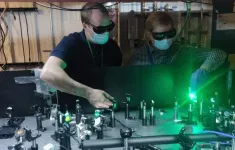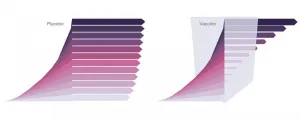(Press-News.org) LOS ALAMOS, N.M., March 25, 2021--A new class of quantum dots deliver a stable stream of single, spectrally tunable infrared photons under ambient conditions and at room temperature, unlike other single photon emitters. This breakthrough opens a range of practical applications, including quantum communication, quantum metrology, medical imaging and diagnostics, and clandestine labeling.
"The demonstration of high single-photon purity in the infrared has immediate utility in areas such as quantum key distribution for secure communication," said Victor Klimov, lead author of a paper published today in Nature Nanotechnology by Los Alamos National Laboratory scientists.
The Los Alamos team has developed an elegant approach to synthesizing the colloidal-nanoparticle structures derived from their prior work on visible light emitters based on a core of cadmium selenide encased in a cadmium sulfide shell. By inserting a mercury sulfide interlayer at the core/shell interface, the team turned the quantum dots into highly efficient emitters of infrared light that can be tuned to a specific wavelength.
"This new synthesis allows for highly accurate, atomic-level control of the thickness of the emitting mercury sulfide interlayer. By changing it in increments of a single atomic layer, we can tune the wavelength of the emitted light in discrete quantized jumps, and further adjust it in a more continuous fashion by tuning the cadmium selenide core size," said Vladimir Sayevich, the lead chemist on this project.
Far superior to existing near-infrared quantum dots, these new structures show "blinking-free" emission at a single-dot level, nearly perfect single-photon purity at room temperature (which produces "quantum light"), and fast emission rates. They behave extremely well with both optical and electrical excitation.
Single photons can be used as qubits in quantum computing. In a cybersecurity application, single photons can protect a computer network through quantum key distribution, which provides ultimate security through "unbreakable" quantum protocols.
Bio-imaging is another important application. The emission wavelength of the newly developed quantum dots is within the near-infrared bio-transparency window, which makes them well suited for deep tissue imaging.
People can't see infrared light, but many modern technologies rely on it, from night-vision devices and remote sensing to telecommunications and biomedical imaging. Infrared light is also a big player in emerging quantum technologies that rely on the duality of light particles, or photons, which can also behave as waves. Exploiting this quantum property requires sources of "quantum light" that emit light in the form of individual quanta, or photons.
"There is also a cool chemical element in achieving single-atomic layer accuracy in making these dots," said Zack Robinson, the project member focusing on quantum dot spectroscopy. "The thickness of the emitting mercury sulfide interlayer is identical across all dots in the samples. That's very unique, especially for a material made chemically in a beaker."
Klimov added, "However, this is just the first step. In order to take full advantage of 'quantum light' one needs to achieve photon indistinguishability, that is, to make sure that all emitted photons are quantum-mechanically identical. This is an extremely difficult task, which we will tackle next in our project."
INFORMATION:
The paper: "Highly versatile near-infrared emitters based on an atomically defined HgS interlayer embedded into a CdSe/CdS quantum dot," Vladimir Sayevich, Zachary L. Robinson, Younghee Kim, Oleg V. Kozlov, Heeyoung Jung,Tom Nakotte, Young-Shin Park, and Victor I. Klimov, Nature Nanotechnology. DOI 10.1038/s41565-021-00871-x or https://dx.doi.org/10.1038/s41565-021-00871-x
The funding: The synthetic and device part of this work were funded by the Los Alamos Laboratory Directed Research (LDRD) project "Quantum photonics with semiconductor nanocrystals." Ultrafast spectroscopic studies were funded by the U.S. Department of Energy-Office of Basic Energy Sciences project "Photoinduced dynamics at chemically assembled quantum interfaces" within the Solar Photochemistry Program.
About Los Alamos National Laboratory
Los Alamos National Laboratory, a multidisciplinary research institution engaged in strategic science on behalf of national security, is managed by Triad, a public service oriented, national security science organization equally owned by its three founding members: Battelle Memorial Institute (Battelle), the Texas A&M University System (TAMUS), and the Regents of the University of California (UC) for the Department of Energy's National Nuclear Security Administration.
Los Alamos enhances national security by ensuring the safety and reliability of the U.S. nuclear stockpile, developing technologies to reduce threats from weapons of mass destruction, and solving problems related to energy, environment, infrastructure, health, and global security concerns.
LA-UR-21-22640
Opioids are the main driver of fatal drug overdoses in the United States, according to the Centers for Disease Control and Prevention, resulting in 46,802 deaths in 2018, usually because the person stops breathing.
Naloxone -- a Food and Drug Administration-approved medication used to reverse overdoses from opioids, such as heroin, morphine and oxycodone -- works by restoring normal respiration to a person whose breathing has slowed or stopped.
"Opioid overdoses cause the largest number of accidental and avoidable deaths," said Peter Davidson, PhD, associate professor in the Department of Medicine at University of California San Diego School of Medicine. "The human toll of drug addiction is devastating. Using naloxone to prevent opiate overdoses can and has saved many lives."
In ...
A major goal of organic and medicinal chemistry in recent decades has been the rapid synthesis of three-dimensional molecules for the development of new drugs. These drug candidates exhibit a variety of improved properties compared to predominantly flat molecular structures, which are reflected in clinical trials by higher efficacy and success rates. However, they could only be produced at great expense or not at all using previous methods. Chemists led by Prof. Frank Glorius (University of Münster, Germany) and his colleagues Prof. M. Kevin Brown (Indiana University Bloomington) and Prof. Kendall N. Houk (University of California, Los Angeles) have now succeeded in converting several classes of flat ...
Skoltech scientists and their colleagues have proposed a new human height inheritance model that accounts for the interaction between various factors that influence adult human height. The research was published in the European Journal of Human Genetics.
Human height is a classical quantitative trait that depends on sex, genetics, and the environment.
Scientists from Skoltech, Novosibirsk State University, the Institute of Cytology and Genetics of the Siberian Branch of RAS, and the Institute of Science and Technology in Vienna analyzed the human height distribution ...
Buried beneath 20 kilometers of ice, the subsurface ocean of Enceladus--one of Saturn's moons--appears to be churning with currents akin to those on Earth.
The theory, derived from the shape of Enceladus's ice shell, challenges the current thinking that the moon's global ocean is homogenous, apart from some vertical mixing driven by the warmth of the moon's core.
Enceladus, a tiny frozen ball about 500 kilometers in diameter (about 1/7th the diameter of Earth's moon), is the sixth largest moon of Saturn. Despite its small size, Enceladus attracted the ...
About two decades after first devising a new kind of vaccine, Oregon Health & Science University researchers are unlocking why it stops and ultimately clears the monkey form of HIV, called SIV, in about half of nonhuman primates - and why it's a promising candidate to stop HIV in people.
In scientific papers that were simultaneously published today in the journals Science and Science Immunology, creators of the cytomegalovirus, or CMV, vaccine platform describe the unusual biological mechanisms through which it works.
The findings also helped fine-tune VIR-1111, the CMV-based experimental vaccine against HIV that was developed at OHSU and is now being evaluated in a Phase 1 clinical trial. The trial is being conducted by Vir Biotechnology, which ...
SILVER SPRING, Md. - As concern has grown over COVID-19 variants and their implications for how well COVID-19 vaccines will protect against the virus, researchers have proposed a method to examine instances of SARS-COV-2 infections in people who have received a COVID-19 vaccine.
Genomic sieve analysis of these so-called "breakthrough" SARS-CoV-2 infections in COVID vaccine trials is a critical tool to identify viral mutations associated with vaccine failure and to predict how vaccination impacts the virus' evolution.
Dr. Morgane Rolland, Chief of Viral Genetics ...
Scientists at Sinai Health say they have discovered a new pathway that controls dangerous overreactions in a body's immune system, including deadly forms of hyper-inflammation.
In new findings out today in the journal Science, researchers at the Lunenfeld-Tanenbaum Research Institute (LTRI) detail how a protein known as WAVE2, a protein expressed in all immune cells, plays a critical role in maintaining immune system balance.
As part of the research, scientists knocked out, or turned off, WAVE2 in a subset of immune cells in mice, which led to severe autoimmunity and inflammation, ...
Despite having remarkable utility in treating movement disorders such as Parkinson's disease, deep brain stimulation (DBS) has confounded researchers, with a general lack of understanding of why it works at some frequencies and does not at others. Now a University of Houston biomedical engineer is presenting evidence in Nature Communications Biology that electrical stimulation of the brain at higher frequencies (>100Hz) induces resonating waveforms which can successfully recalibrate dysfunctional circuits causing movement symptoms.
"We investigated the modulations in local ?eld potentials induced by electrical stimulation of the subthalamic nucleus (STN) at therapeutic ...
Tel-Aviv, ISRAEL - March 25, 2021 - Wild Biotech, a preclinical stage drug discovery & development company emerging out of stealth mode, today announces the publication of its first major paper, which appears in the journal Science. The study mapped the gut microbiota of animals in the wild on an unprecedented scale, adding millions of potentially novel microbiome-based therapeutics for human diseases to the company's already massive database. Wild will use these findings to first tap its database for targets in inflammatory, immune and gastrointestinal diseases.
"For the study, we collected gut microbiota from almost 200 species of animals in the wild, covering diverse classes, feeding behaviors, geographies, and ...
Water scarcity in rural Alaska is not a new problem, but the situation is getting worse with climate change. Lasting solutions must encourage the use of alternative water supplies like rainwater catchment and grey water recycling. They must also address the affordability of water related to household income, say researchers from McGill University.
Washing hands with clean water is something most people take for granted, yet for Alaska's rural residents, this is often not the case. When people pay for water by the gallon, serious thought is given to how much is used - even during the COVID-19 pandemic.
In many rural Alaskan communities, where jobs are scarce and household income is low, the cost of water is a high burden, according to the study published in Environmental ...





